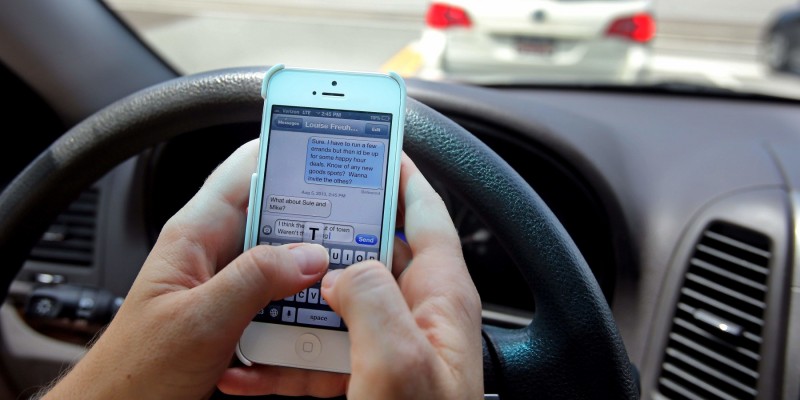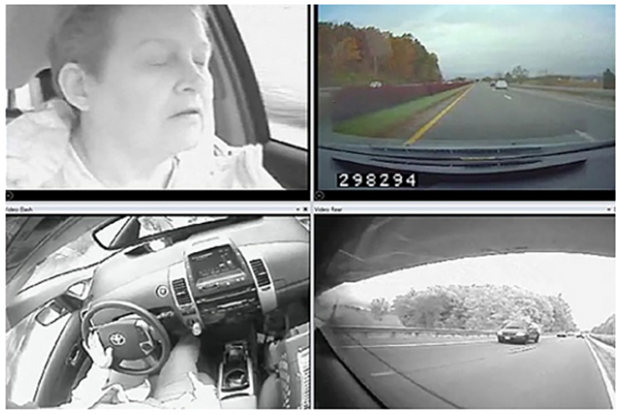
Until sometime in the early 2000s, the U.S. had fewer traffic fatalities per mile traveled than most developed countries. That’s changed. If we’re measuring by road traffic deaths per 100,000 people, the U.S. is currently ranked 17th out of 29 high-income nations for which data is available. By road fatalities, America loses out to the United Kingdom (11.4 deaths versus 3.7). It loses out to Canada (6.8). It loses out to the Philippines (9.1) and Brunei (6.8).
What’s changed? Researchers with the Virginia Tech Transportation Institute (VTTI) have a theory: American drivers have simply gotten worse at driving. In a new study published in the Proceedings of the National Academy of Sciences last month, the scientists report that people behind the wheels of passenger vehicles are distracted more than 50 percent of the time. That doubles their risk of a crash. Nearly 70 percent of the crashes the researchers analyzed involved “some type of observable distraction,” they wrote.
“These findings are important because we see a younger population of drivers, particularly teens, who are more prone to engaging in distracting activities while driving,” Tom Dingus, the study’s lead author and the director of VTTI, said in a statement. “Our analysis shows that, if we take no steps in the near future to limit the number of distracting activities in a vehicle, those who represent the next generation of drivers will only continue to be at greater risk of a crash.”
The main culprit, of course, is the cell phone.
Cell phones on the road
To complete their study, the Virginia Tech researchers, led by Dingus, used a large, unprecedented, and government-sponsored naturalistic driving dataset. The numbers in this set come from more than 3,500 study participants who agreed to let researchers mount cameras, sensors, and radar inside their vehicles, tracking and filming the drivers everywhere they went for a three-year period. Researchers observed exactly what happens before a crash, capturing more than 35 million miles of data in all.
And they saw cell phones — oh, they saw cell phones. Drivers were observed dialing a phone just 0.14 percent of the time, but the act raised the odds of an accident by a factor of 12 compared to what the researchers call “model driving,” or driving while “alert, attentive, and sober.” Texting occurred 1.91 percent of the time, leading to a risk increase by a factor of six. Drivers talked on the phone 3.24 percent of the time, and chatting more than doubled the risk of an incident. Just reaching for a handheld cell phone increased the odds of an accident nearly five times.
Other curious distractions
But distractions didn’t end at dialing, texting, or reaching for a phone. Researchers observed drivers chatting with a teen or adult passenger 14.6 percent of the time. This didn’t have a huge effect—it raised the risk by a factor of 1.4—but it’s high enough to be interesting. That’s because previous studies have shown that interacting with adult passengers in the front seat might actually have a “protective effect,” which lowers the crash risk below even what it would be if the drivers were simply performing “model driving.” The Virginia Tech researchers posit that this is either because their videos didn’t pick up on all conversations, so they’re overestimating the dangerousness of chatting, or because they purposefully oversampled teenage drivers. Previous work has found that young and inexperienced drivers are particularly horrible at multitasking in cars, so passengers, beware—don’t bother the driving teens.
Another risky distraction—technically an “impairment,” according to the researchers—is driving while emotional. Researchers observed “sadness, crying, and/or emotional agitations” only about 0.2 percent of the time, but loosing one’s feelings behind the wheel increased the risk of an incident by nearly 1000 percent compared to model driving.
What distractions seemed a-okay? Applying makeup while driving didn’t appear to be as risk-averse as it seems, the researchers found. Eating and drinking (nonalcoholic beverages, duh) didn’t make much of a difference, either, according to the results. Still, the prudent driver is best off scarfing those tacos in the parking lot before hitting the highway.
Drinking and driving is terrible, too
Of course, distracted driving doesn’t have a lock on dangerous behind-the-wheel behaviors. Imbibing before driving is perilous, too. Drug and alcohol use was observed just 0.1 percent of the time, but it increased the risk of crash by a factor of 40.
Driving deaths have been falling in the U.S. for a number of years, thanks to improved vehicle safety and road design. Still, in 2013, 32,719 people died on American roads. The VTTI researchers estimate that potentially 36 percent of incidents—4 million of the almost 11 million crashes that happen in this country annually—“could be avoided if no distraction was present.” Driving distracted is serious business, and well-enforced bans preventing it could make a serious difference.
U.S Drivers Are Distracted More Than Half the Time They’re Behind the Wheel | City Labs



